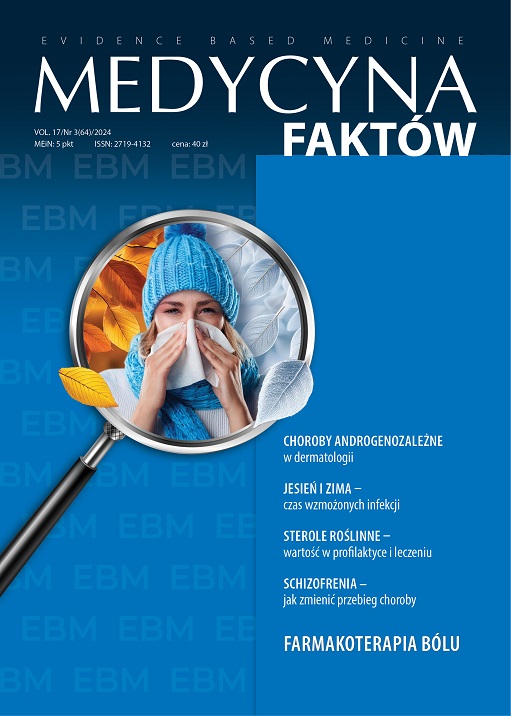Fakty i mity na temat buprenorfiny Artykuł przeglądowy
##plugins.themes.bootstrap3.article.main##
Abstrakt
Opioidy są podstawowymi, skutecznymi lekami w terapii bólu ostrego i przewlekłego o umiarkowanym i dużym natężeniu, nie tylko w chorobach nowotworowych, ale także w bólach pochodzenia nienowotworowego. Nawet przy podobnych rodzajach czy natężeniu bólu występują indywidualne różnice między pacjentami pod względem skutecznej dawki i ryzyka wystąpienia określonych działań niepożądanych. Wybór analgetyku opioidowego w praktyce opiera się na wiedzy na temat różnic między poszczególnymi lekami, w tym dotyczących powinowactwa do poszczególnych typów receptorów opioidowych, siły działania analgetycznego, właściwości fizykochemicznych, a także, co ważniejsze w klinice, profilu bezpieczeństwa i skuteczności w poszczególnych zespołach bólowych.
Buprenorfina zajmuje ważne miejsce w medycynie bólu ze względu na unikalny profil bezpieczeństwa na tle innych leków opioidowych. Obejmuje on efekt pułapowy w stosunku do depresji oddechowej i euforii, brak kumulacji w przypadku niewydolności nerek, działanie antyhiperalgetyczne, mniejsze ryzyko tachyfilaksji, nadużywania, immunosupresji oraz wpływu na funkcje seksualne w stosunku do morfiny czy fentanylu.
##plugins.themes.bootstrap3.article.details##
Copyright © by Medical Education. All rights reserved.
Bibliografia
2. Lutfy K, Cowan A. Buprenorphine: A Unique Drug with Complex Pharmacology. Curr Neuropharmacol. 2004; 2(4) :395-402. http://doi.org/10.2174/1570159043359477.
3. Cruciani R, Knotkova H (eds). Handbook of Methadone Prescribing and Buprenorphine Therapy. Springer, 2013.
4. Dahan A, Yassen A, Romberg R et al. Buprenorphine induces ceiling in respiratory depression but not in analgesia. Br J Anaesth. 2006; 96(5): 627-32. http://doi.org/10.1093/bja/ael051.
5. FDA warns about serious breathing problems with seizure and nerve pain medicines gabapentin (Neurontin, Gralise, Horizant) and pregabalin (Lyrica, Lyrica CR). Published online January 30, 2020.
6. Benzodiazepines and opioids: reminder of risk of potentially fatal respiratory depression. Published online March 18, 2020.
7. Koppert W, Ihmsen H, Körber N et al. Different profiles of buprenorphine-induced analgesia and antihyperalgesia in a human pain model. Pain. 2005; 118(1): 15-22. http://doi.org/10.1016/j.pain.2005.06.030.
8. Riblet NB, Young-Xu Y, Shiner B et al. The efficacy and safety of buprenorphine for the treatment of depression: A systematic review and meta-analysis. J Psychiatr Res. 2023; 161: 393-401. http://doi.org/10.1016/j.jpsychires.2023.03.037.
9. Leffler A, Frank G, Kistner K et al. Local Anesthetic-like Inhibition of Voltage-gated Na+Channels by the Partial μ-opioid Receptor Agonist Buprenorphine. Anesthesiology. 2012; 116(6): 1335-46. http://doi.org/10.1097/ALN.0b013e3182557917.
10. Jaramillo-Polanco J, Lopez-Lopez C, Yu Y et al. Opioid-Induced Pronociceptive Signaling in the Gastrointestinal Tract Is Mediated by Delta-Opioid Receptor Signaling. J Neurosci. 2022; 42(16): 3316-28. http://doi.org/10.1523/JNEUROSCI.2098-21.2022.
11. Sittl R, Nuijten M, Poulsen Nautrup B. Patterns of Dosage changes with transdermal buprenorphine and transdermal fentanyl for the treatment of noncancer and cancer pain: A retrospective data analysis in Germany. Clin Ther. 2006; 28(8): 1144-54. http://doi.org/10.1016/j.clinthera.2006.08.002.
12. Gudin J, Fudin J. A Narrative Pharmacological Review of Buprenorphine: A Unique Opioid for the Treatment of Chronic Pain. Pain Ther. 2020; 9(1): 41-54. http://doi.org/ 10.1007/s40122-019-00143-6.
13. Induru RR, Davis MP. Buprenorphine for Neuropathic Pain – Targeting Hyperalgesia. Am J Hosp Palliat Med. 2009; 26(6): 470-3. http://doi.org/10.1177/1049909109341868.
14. Wolff RF, Aune D, Truyers C et al. Systematic review of efficacy and safety of buprenorphine versus fentanyl or morphine in patients with chronic moderate to severe pain. Curr Med Res Opin. 2012; 28(5): 833-45. http://doi.org/10.1185/03007995.2012.678938.
15. Pergolizzi JV, Mercadante S, Echaburu AV et al. The role of transdermal buprenorphine in the treatment of cancer pain: an expert panel consensus. Curr Med Res Opin. 2009; 25(6): 1517-28. http://doi.org/10.1185/03007990902920731.
16. Bradley A, Boland JW. Effects of Opioids on Immune and Endocrine Function in Patients with Cancer Pain. Curr Treat Options Oncol. 2023; 24(7): 867-79. http://doi.org/10.1007/s11864-023-01091-2.
17. Kögel B, Christoph T, Strassburger W et al. Interaction of mu-opioid receptor agonists and antagonists with the analgesic effect of buprenorphine in mice. Eur J Pain. 2005; 9(5): 599-611.
18. Paronis CA, Bergman J. Buprenorphine and opioid antagonism, tolerance, and naltrexone-precipitated withdrawal. J Pharmacol Exp Ther. 2011; 336(2): 488-95. http://doi.org/ 10.1124/jpet.110.173823.
19. Pergolizzi J, Böger RH, Budd K et al. Opioids and the Management of Chronic Severe Pain in the Elderly: Consensus Statement of an International Expert Panel with Focus on the Six Clinically Most Often Used World Health Organization step III Opioids (Buprenorphine, Fentanyl, Hydromorphone, Methadone, Morphine, Oxycodone). Pain Pract. 2008; 8(4): 287-313. http://doi.org/10.1111/j.1533-2500.2008.00204.x.
20. Gianni W, Madaio AR, Ceci M et al. Transdermal Buprenorphine for the Treatment of Chronic Noncancer Pain in the Oldest Old. J Pain Symptom Manage. 2011; 41(4): 707-14. http://doi.org/10.1016/j.jpainsymman.2010.06.015.
21. Widenka M, Leppert W. Assessment of analgesic effects of different initial doses of transdermal buprenorphine in the treatment of chronic pain in the elderly diagnosed with osteoarthritis. J Physiol Pharmacol. 2020; 71(5). http://doi.org/ 10.26402/jpp.2020.5.13.
22. Vestergaard P, Rejnmark L, Mosekilde L. Fracture risk associated with the use of morphine and opiates. J Intern Med. 2006; 260(1): 76-87. http://doi.org/10.1111/j.1365-2796.2006.01667.x .
23. Hirst A, Knight C, Hirst M et al. Tramadol and the risk of fracture in an elderly female population: a cost utility assessment with comparison to transdermal buprenorphine. Eur J Health Econ. 2016; 17(2): 217-27. http://doi.org/10.1007/s10198-015-0673-1.
24. Lintula E, Tiihonen M, Taipale H et al. Opioid Use After Hospital Care due to Hip Fracture Among Community-Dwelling Persons With and Without Alzheimer’s Disease. Drugs Aging. 2020; 37(3): 193-203. http://doi.org/10.1007/s40266-019-00734-0.
25. Filitz J, Griessinger N, Sittl R et al. Effects of intermittent hemodialysis on buprenorphine and norbuprenorphine plasma concentrations in chronic pain patients treated with transdermal buprenorphine. Eur J Pain. 2006; 10(8): 743-8. http://doi.org/10.1016/j.ejpain.2005.12.001.
26. Böger RH. Renal impairment: a challenge for opioid treatment? The role of buprenorphine. Palliat Med. 2006; 20(Suppl 1): 17-23.
27. Bettinger J, Batista Quevedo H, Cleary J. Emerging pharmacologic mechanisms of buprenorphine to explain experience of analgesia versus adverse effects. J Opioid Manag. 2021; 17(7): 21-31. http://doi.org/10.5055/jom.2021.0639.
